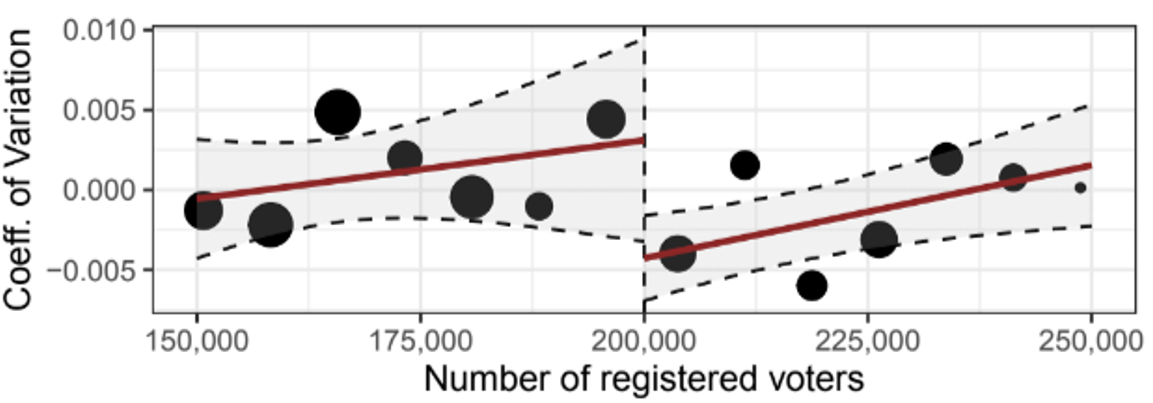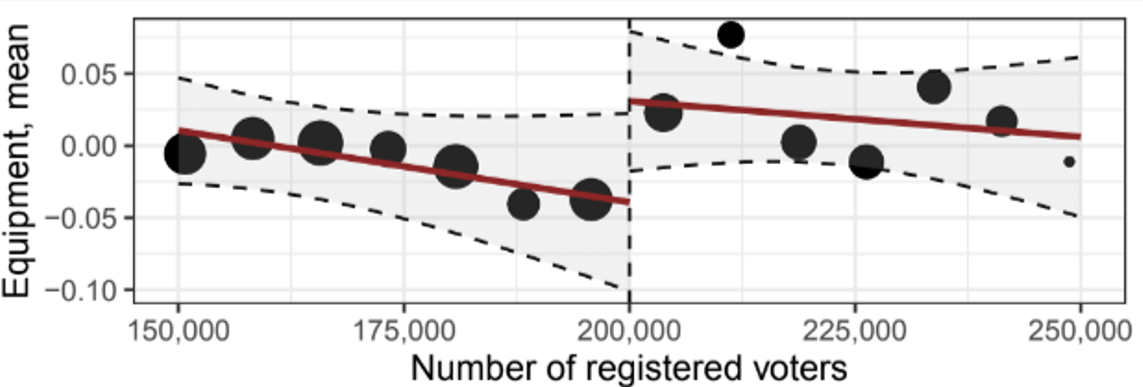
When electoral rules encourage politicians to secure a broader base of support, politicians provide public goods more broadly
Economists have long focused on the integral role of ‘inclusive institutions’ – those that encourage broad political participation – in fostering long-term, broad-based economic growth (Acemoglu and Robinson 2008). Elections are one of the most fundamental institutions in democracies, governing how political power and economic resources are shared. Therefore, the way that elections are designed, and how this shapes politicians incentives, can have a profound effect on political and economic outcomes. It can drive the platform and policies of a candidate, and how politicians appeal to and ultimately represent different groups of voters.
A large body of theory argues that incentivising politicians to appeal to broader groups of voters can lead them to also provide public goods more broadly (Genicot et al. 2021, Lizzeri and Persico 2001, Milesi-Ferretti et al. 2002, Persson and Tabellini 1999). However, we lack systemic evidence on whether electoral design is effective in providing such incentives and improving economic outcomes. My paper (Chin 2023) empirically examines how one aspect of electoral design – namely, the electoral rule and whether elections feature a single or two rounds – can encourage politicians to appeal to a broader constituency and lead to improved economic outcomes.
Electoral rules shape political incentives
Electoral rules are formulas that map votes to electoral outcomes, and thus dictate how voters preferences are translated into political representation. These formulas can create incentives for politicians to appeal to broader groups of voters.
Compare single-round and two-round systems. In a single-round system, voters vote once and the candidate with the most votes wins. In a two-round system, voters first vote and if no candidate receives a majority, they vote a second time between the top two candidates.
This distinction means that to win in a two-round system, candidates not only have to obtain the most votes (which could be as little as, say, 30% in a single-round system) but they must also obtain at least 50%. In a two-round system, every vote becomes more valuable and it becomes more costly for a candidate to ignore certain groups of voters. As a result, in order to win, candidates must offer to enact policies that appeal to broader groups of voters. To the extent that politicians commit to their campaign promises, these strategies can lead politicians to provide public goods more broadly once elected.
This logic can be applied to other electoral rules, such as proportional systems and the electoral college. For example, Lizzeri and Persico (2001) argue that the electoral college works against encouraging majority representation, as candidates can win with only 25% of the vote (by winning 50% of the vote in 50% of districts).
Electoral rules in a laboratory in Brazil
A variety of electoral rules are used around the world to select political representatives. For executive positions in presidential systems, these generally fall under two systems: single-round and two-round systems. However, electoral rules are rarely chosen in isolation of political and economic motivations, making studying their causal effects difficult.
An ideal experiment would randomly assign an electoral rule to each election. Brazilian municipal elections provide such an experiment. In Brazil, municipalities with less than 200,000 registered voters elect their mayor in a single-round system, and municipalities with more than 200,000 registered voters do so in a two-round system. To establish the causal effect of the electoral rule, I compare political and economic outcomes in municipalities within a small window (+/- 50,000 voters) of this threshold. Narrowing the sample of municipalities to those within this small window ensures that the municipalities being compared are similar along observable demographic and economic characteristics.
Politicians in two-round systems represent a broader group of voters
In the first step of my analysis, I show that politicians in two-round systems receive broader geographic support. Using highly disaggregated vote counts at each voting machine, I calculate how geographically concentrated votes are in the first round of voting. In municipalities with two-round systems, these vote counts are less geographically concentrated. This decrease only occurs among the top two candidates, which means that whoever wins ultimately represents a geographically broader constituency.
Figure 1: Concentration of voters for specific candidates, as measured by the coefficient of variation index

Two-round elections foster inclusiveness along another dimension: voters are more engaged in the political process and cast significantly fewer blank and invalid ballots.
Politicians in two-round systems provide more public goods and distribute them more broadly
In the second step of my analysis, I examine whether these differences in geographical representation translate into economic policy. To do this, I measure the level of resources present in public elementary schools in the municipality (elementary schools are one of the main responsibilities of municipal governments, and are extremely localised public goods). Once in office, politicians elected under two-round systems provide more resources to public schools and distribute these resources more equitably across schools. This lower inequality is driven by additional resources going to the poorest schools in the municipality.
Figure 2: Level of equipment resources in schools, as measured by the average national percentile rank in resource levels of schools in the municipality

Figure 3: Inequality of equipment resources across schools, as measured by the standard deviation in national percentile rank in resource levels across schools in the municipality

This pattern of resource provision to schools also results in improved education outcomes: drop-out rates are lower and literacy rates higher among cohorts who were of school age during the electoral term.
How can we make the political process more inclusive?
These results suggest that thoughtful design of elections can make the political system, and subsequent economic policy, more inclusive. When politicians have incentives to appeal to broader groups of voters, they represent a broader constituency and provide public goods more broadly. As a result, policy tools that make it more difficult for politicians to win with narrow groups of voters – whether by changing the electoral rule, limiting the number of candidates in single-round elections, or discouraging personality politics – can generate meaningful steps towards making the political process more inclusive.
References
Acemoglu, D and J A Robinson (2008), “Persistence of Power, Elites, and Institutions”, American Economic Review 98(1): 267–293.
Chin, M (2023), “When Do Politicians Appeal Broadly? The Economic Consequences of Electoral Rules in Brazil”, American Economic Journal: Applied Economics 15(3): 1-28.
Genicot, G, L Bouton and M Castanheira (2021), “Electoral Systems and Inequalities in Government Interventions”, Journal of the European Economic Association 19: 3154–3206.
Lizzeri, A and N Persico (2001), “The Provision of Public Goods under Alternative Electoral Incentives”, American Economic Review 91(1): 225–39.
Milesi-Ferretti, G M, R Perotti and M Rostagno (2002), “Electoral Systems and Public Spending”, Quarterly Journal of Economics 117(2): 609–57.
Persson, T and G Tabellini (1999), “The Size and Scope of Government: Comparative Politics with Rational Politicians”, European Economic Review 43 (4–6): 699–735.

